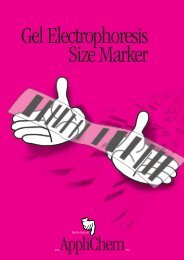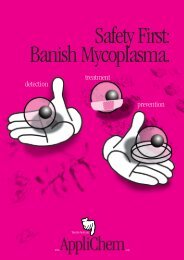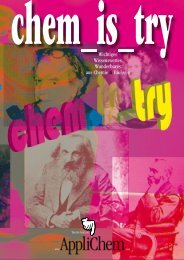Transfer Membranes
Transfer Membranes
Transfer Membranes
Create successful ePaper yourself
Turn your PDF publications into a flip-book with our unique Google optimized e-Paper software.
Colloidal Silver Enhancement<br />
Use 77 mM hydroquinone, 5.5 mM silver lactate in 100 mM citrate buffer at pH 3.85. Make reagent in a darkened container<br />
as it is photosensitive. After the enhancement is complete, soak the blot in fixing solution for 5 minutes followed by a rinse<br />
in water.<br />
Coomassie Blue or Amido Black<br />
Soak the membrane in either dye for 10 to 15 minutes. Destaining should immediately follow with 45 % methanol and 7 %<br />
acetic acid for Amido Black, or 50 % methanol and 10 % acetic acid for Coomassie blue. Destaining should continue for<br />
10 to 15 minutes. Placing the blots into 90 % methanol for 1 to 2 minutes after destaining will remove any residual stain.<br />
Ponceau S<br />
After blotting, rinse the PVDF-Star with deionized water. Apply 0.2 % Ponceau-S for 1 minute then rinse with deionized water<br />
to remove excess stain.<br />
Storage<br />
Membrane blots can be dried and stored at 4°C for use at a later date. Rewet the membrane by placing the membrane in<br />
a small volume of 100 % methanol for 1 – 2 seconds, then placing it in a large volume of deionized water to remove the<br />
methanol. If exposure to methanol is to be avoided, the blot can be taken directly to protein “blocking” and then air-dried.<br />
This will coat the membrane with hydrophilic protein and allows for rewetting in antibody incubation solution. When stored<br />
dry, the blots will remain stable for up to one year<br />
19<br />
protocol<br />
Protocol 20: Protein Dot Slot Blotting with PVDF (Polyvinylidene Fluoride) <br />
<strong>Transfer</strong> <strong>Membranes</strong><br />
Sample Preparation<br />
Suspend purified samples in a buffer solution such as PBS or TBS. If a filtration manifold is being used, the samples should<br />
be diluted to between 300 – 500 µl for a concentration of between 1 – 10 µg/spot. Serial dilutions of the sample can be<br />
performed to determine the optimal concentrations for subsequent binding assays. If a filtration manifold is not being used,<br />
volumes should be between 2 – 5 µl. Increase the sample concentration and reapply until the appropriate amount of sample<br />
is immobilized.<br />
Membrane Preparation<br />
Soak the membrane in 100 % methanol until complete saturation is reached, then soak the membrane in PBS or TBS until<br />
it is used.<br />
Sample Application<br />
Place the membrane as flat as possible on dry sheets of absorbent blotting paper. Apply 2 – 5 ml of sample to the membrane.<br />
If larger volumes are used, the samples should be allowed to spot dry prior to subsequent sample application. If a filtration<br />
manifold is being used, place two sheets of absorbent blotting paper in the filter support plate. The membrane should be<br />
placed on top of the absorbent paper and clamp the sample well plate into place. Apply low vacuum and wash the individual<br />
wells with 500 µl of sample buffer. Add sample to the well and filter through. Follow sample filtration with a wash of 500<br />
µl of sample buffer.<br />
20<br />
protocol<br />
p r o t o c o l s<br />
© 2008 AppliChem • <strong>Transfer</strong> <strong>Membranes</strong> 41





